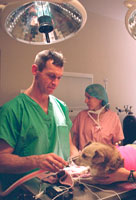For Immediate Release
New, State-of-the-Art Procedure Is a Minimally Invasive, More Cost-Effective Alternative to Traditional Canine Knee-Repair Techniques, Results in Fewer Complications
San Francisco, Calif., Jan. 13, 2009—San Francisco Veterinary Specialists, Inc. (SFVS), the first and only multi-specialty referral hospital in San Francisco, is now offering the Tightrope CCL surgery to repair dogs’ cranial cruciate ligament (CCL)—an important stabilizing structure in the canine knee, or stifle. CCL injuries in canines can lead to partial or complete joint instability, resulting in arthritis, pain and lameness.
Every year, veterinarians perform over 1.2 million knee surgeries on dogs in the United States. This is approximately five times greater than the number of knee surgeries performed on humans. Traditionally, the most commonly performed techniques to address CCL injuries include Tibial Plateau Leveling Osteotomy (TPLO), Extra Capsular Suture Repair (Ex-Cap) and Tibial Tuberosity Advancement (TTA). Recently at the University of Missouri College of Veterinary Medicine, Dr. James Cook worked with Arthrex Inc. to develop and test the less invasive Tightrope procedure for dogs as an alternative to the current options employed by orthopedic surgeons.
“Just as in human medicine, techniques and technology are always evolving in veterinary care. At SFVS, we are happy to be able to offer cutting-edge procedures such as the Tightrope technique—helping to ensure that pet owners can get the most appropriate and advanced care for their pets,” said Philip Watt, BVSc, MACVSc, FACVS, head of SFVS’s surgery department.
Unlike the aforementioned surgical options, the Tightrope procedure utilizes a fiber tape suture material, which is also currently used in human medicine for ankle and shoulder reconstruction. Traditionally, surgeries that correct the CCL deficient stifle involve the shifting of workload to other healthy ligaments, and often require that the leg bones, or tibia, be cut and shifted to compensate for these mechanical changes. The Tightrope procedure, however, is a much simpler technique that replaces the damaged CCL with the fiber tape suture, immediately stabilizing the stifle joint. Compared to other surgical options, the Tightrope procedure:
- Is minimally invasive, as it does not require significant changes to the tibia, such as cutting or plating
- Greatly reduces postoperative pain
- Decreases risk and severity of complications (e.g., infection, implant failure, fractures)
- Is more cost-effective
- Results in surgical outcomes equal to or better than more invasive surgeries
Dr. Watt noted that following the Tightrope procedure, postoperative care and an appropriate rehabilitation period are required to ensure a successful recovery, as with any other surgical procedure. This period, however, is significantly shorter when compared to previously used techniques.
Working with referring veterinarians and pet owners, SFVS surgery staff evaluate patients on a case-by-case basis to determine the most appropriate treatment plan. Unfortunately, not all canines are good Tightrope procedure candidates. “For those that are, we feel it’s a helpful option for both our patients and clients,” said Dr. Watt.
More information on the Tightrope procedure can be found on the University of Missouri’s website, “Technique Used in Human Ankle Injuries Modified to Treat Dogs’ Knees.”